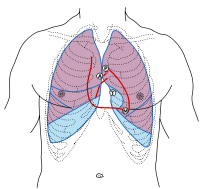
Photo from wikipedia
This letter presents the first implementation of autonomous robotic auscultation of heart and lung sounds. To select auscultation locations that generate high-quality sounds, a Bayesian Optimization (BO) formulation leverages visual… Click to show full abstract
This letter presents the first implementation of autonomous robotic auscultation of heart and lung sounds. To select auscultation locations that generate high-quality sounds, a Bayesian Optimization (BO) formulation leverages visual anatomical cues to predict where high-quality sounds might be located, while using auditory feedback to adapt to patient-specific anatomical qualities. Sound quality is estimated online using machine learning models trained on a database of heart and lung stethoscope recordings. Experiments on 4 human subjects show that our system autonomously captures heart and lung sounds of similar quality compared to tele-operation by a human trained in clinical auscultation. Surprisingly, one of the subjects exhibited a previously unknown cardiac pathology that was first identified using our robot, which demonstrates the potential utility of autonomous robotic auscultation for health screening.
Journal Title: IEEE Robotics and Automation Letters
Year Published: 2022
Link to full text (if available)
Share on Social Media: Sign Up to like & get
recommendations!